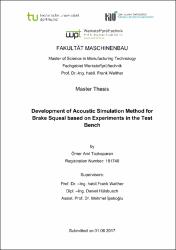| dc.contributor.advisor | İpekoğlu, Mehmet | |
| dc.contributor.author | Tozkoparan, Ömer Anıl | |
| dc.date.accessioned | 2020-03-04T12:58:14Z | |
| dc.date.available | 2020-03-04T12:58:14Z | |
| dc.date.issued | 2017 | |
| dc.identifier.citation | Tozkoparan, Ö. A. (2017). Development of acoustic simulation method for brake squeal based on experiments in the test bench.Türk-Alman Üniversitesi, Fen Bilimleri Enstitüsü, İstanbul | en_US |
| dc.identifier.uri | https://hdl.handle.net/20.500.12846/34 | |
| dc.description.abstract | Brake squeal is a friction-induced high frequency (beyond 1kHz) noise problem that is observed in automotive disc brake systems. As opposed to other friction-induced noise and vibration problems, it is a dynamic instability phenomenon and usually observed at low operating speeds. In order to understand the physical system, first modal tests were performed and eigenfrequencies and modes were determined. These tests were performed by hitting the system by an impact hammer and collecting acceleration data at several locations on the system. These tests were first performed on component level, i.e. components of the brake system such as disc, pad caliper, etc. were investigated. Than, the entire brake system assembly were tested. As an outcome of these studies, the system along with its components were understood in terms of their modal properties. A computational model of the brake system were developed and its modal properties were calculated from the computational solution of the complex eigenvalue problem. These eigenvalues were compared by the experimental modal test results and the computational model were updated. After validating the computational model, it was solved for different operational parameter sets and the unstable modes were determined. In order to validate the computational model, a laboratory test bench was designed and built. On this setup, brake system was attached on a supporting structure that is in a semi-anechoic room, and the experiments were run at different operational conditions such as brake pressure, speed, etc. and squeal phenomenon was generated at the laboratory environment. Based on the experimental measurements, the computational was validated. After validating the computational model with experiments, a new idea to treat squeal problem on the brake system was developed. According to this idea, the computational model was modified and similar computational work was done to see if the solution is effective. Than, these modifications were applied to the physical system, and experimental cases were rerun on the modified system. As a result, the design idea on the brake system showed a better squeal performance. | en_US |
| dc.description.abstract | Tez kapsamında fren sistemi gürültü probleminin çözülmesi için iki farklı yaklaşım izlendi. İlk yaklaşımda genel olarak deneysel yöntemler kullanıldı. Deneysel çalışmalar mevcut fren sisteminin testlerinin yapılması, kurulacak hesaplamalı model için gerekli parametrelerin elde edilmesi ve tez çıktısı olacak yeni tasarlanan fren sisteminin doğrulama testlerinin yapılmasını kapsamaktadır. İlk yapılacak deneylerde mevcut fren sistemi parçaları (fren diski, fren pabucu, kaliper vb.) üzerinde modal testler uygulanıp, bu parçalarının sönüm, katılık gibi modal özellikleri elde edildi. Elde edilen bu parametreler hesaplamalı modelde kullanıldı. Daha sonra fren sisteminin üzerine bağlanabileceği taşınabilir bir test sistemi geliştirilip, yarı yansımasız oda içine yüksek frekanslı gürültü probleminin nedeninin araştırılmasına yönelik testler gercekleştirildi. Yapılan testlerde sabit fren basıncı altında, sabit hızda döndürülen fren diskinin hangi şartlar altında gürültüye neden olduğu belirlendi. Deneyler kapsamında fren sisteminin çeşitli parçaları üzerinden ivme ve ses basıncı gibi sinyaller toplandı; alınan ölçümler ile sistemin mekanik ve akustik modları belirlendi. Bu bilgiler ile hangi sistem bileşeninin bir kararsızlık problemi olan yüksek frekanslı fren gürültüsüne neden olduğu belirlendi. İkinci yaklaşım olan hesaplamalı çalışmalar ise fren sistemi modelinin kurulması, model parametrelerinin deneysel verilere uyacak şekilde ayarlanması ve gürültü probleminin hesaplamalı olarak incelenmesini sağlayan yeni bir simülasyon metodunun oluşturulmasını kapsamaktadır. Bu kapsamda ilk olarak sonlu elemanlar yaklaşımı ile çözülecek bir fren sistemi modeli geliştirildi. Öncelikle deneysel yöntemlerin uygulanacağı disk fren geometrisinin sonlu elemanlar modeli ticari yazılımlar ile oluşturuldu. Sonrasında test düzeneğindeki sınır şartlarını ve parametrelerini içeren simülasyonlar gerçekleştirildi. Simülasyonlarda sürtünme, temas, fren basıncı ve disk dönüş hızı gibi sistemin çeşitli çalışma koşulları da hesaplamaya dahil edildi. Bu şekilde sonlu elemanlar modeli ve simülasyon metodu deney sonuçlarına dayanarak iyileştirilip ve doğrulandı. Son aşamada, gürültü probleminin çözülmesi için gerekli olan iyileştirmeler yeni geliştirilen hesaplama metodu ile belirlendi. Böylece yüksek frekanslı gürültü problemi açısından iyileştirilmiş yeni bir tasarım önerisinde bulunuldu. En son olarak, önerilen tasarımın doğrulama testleri kurulan test sistemi üzerinde yapıldı. | en_US |
| dc.language.iso | eng | en_US |
| dc.publisher | Türk-Alman Üniversitesi | en_US |
| dc.rights | info:eu-repo/semantics/openAccess | en_US |
| dc.subject | Disk fren | en_US |
| dc.subject | Disk brake | en_US |
| dc.title | Development of acoustic simulation method for brake squeal based on experiments in the test bench | en_US |
| dc.type | masterThesis | en_US |
| dc.relation.publicationcategory | Tez | |
| dc.contributor.department | TAÜ, Fen Bilimleri Enstitüsü, İmalat Teknolojisi Ana Bilim Dalı | en_US |
| dc.contributor.institutionauthor | Tozkoparan, Ömer Anıl | en_US |

















